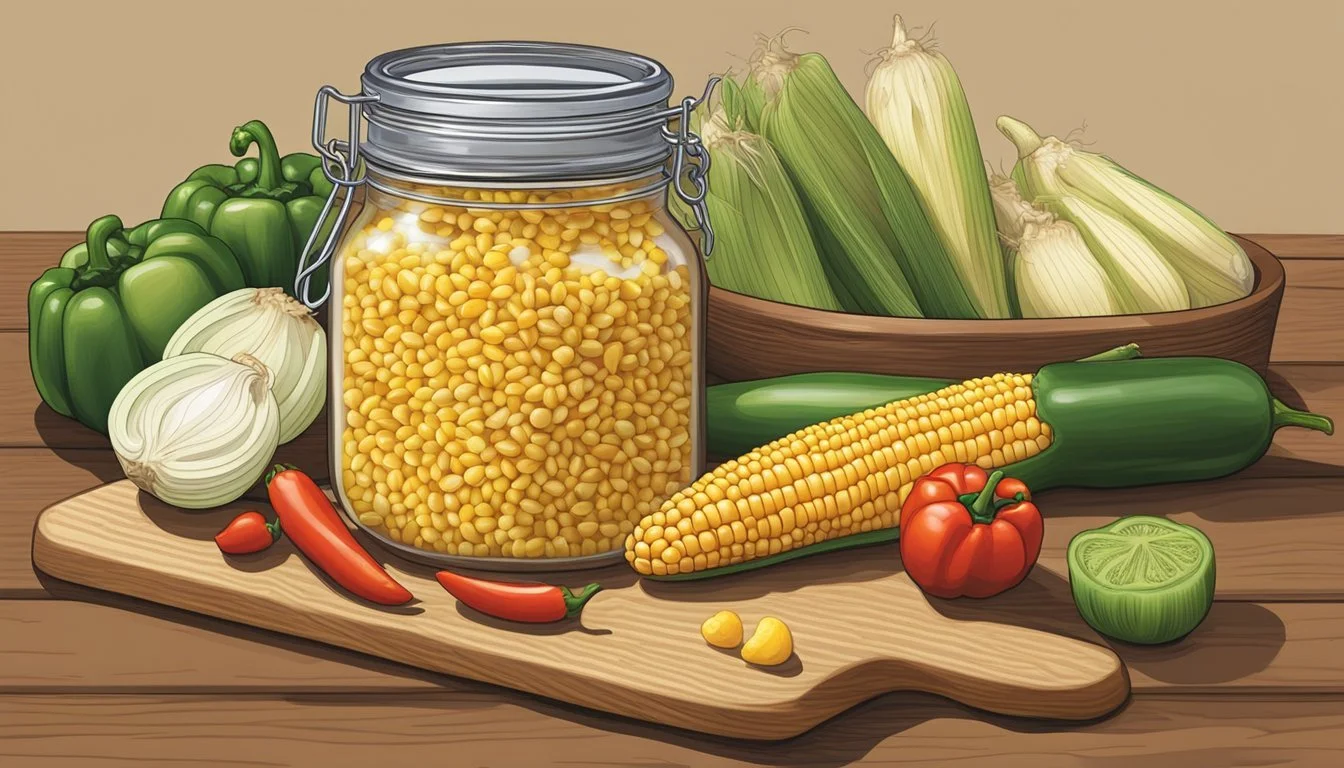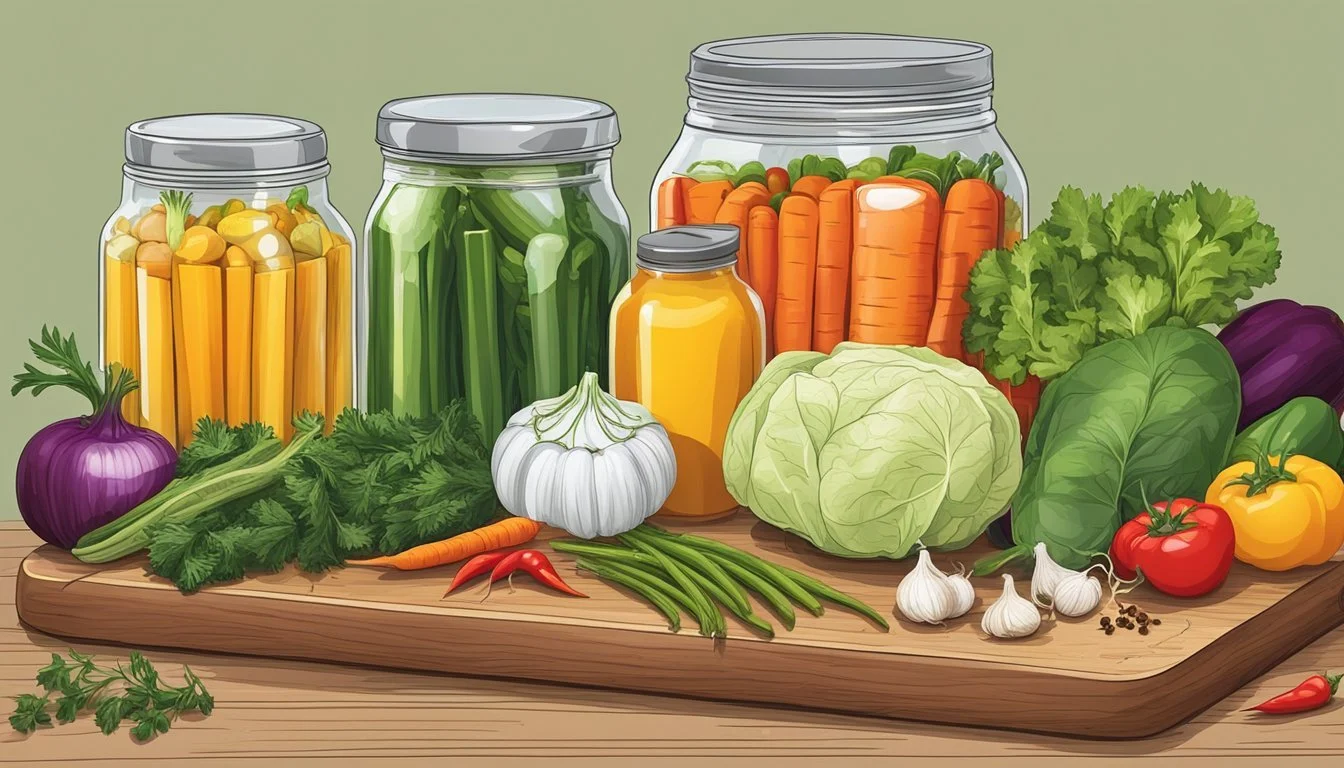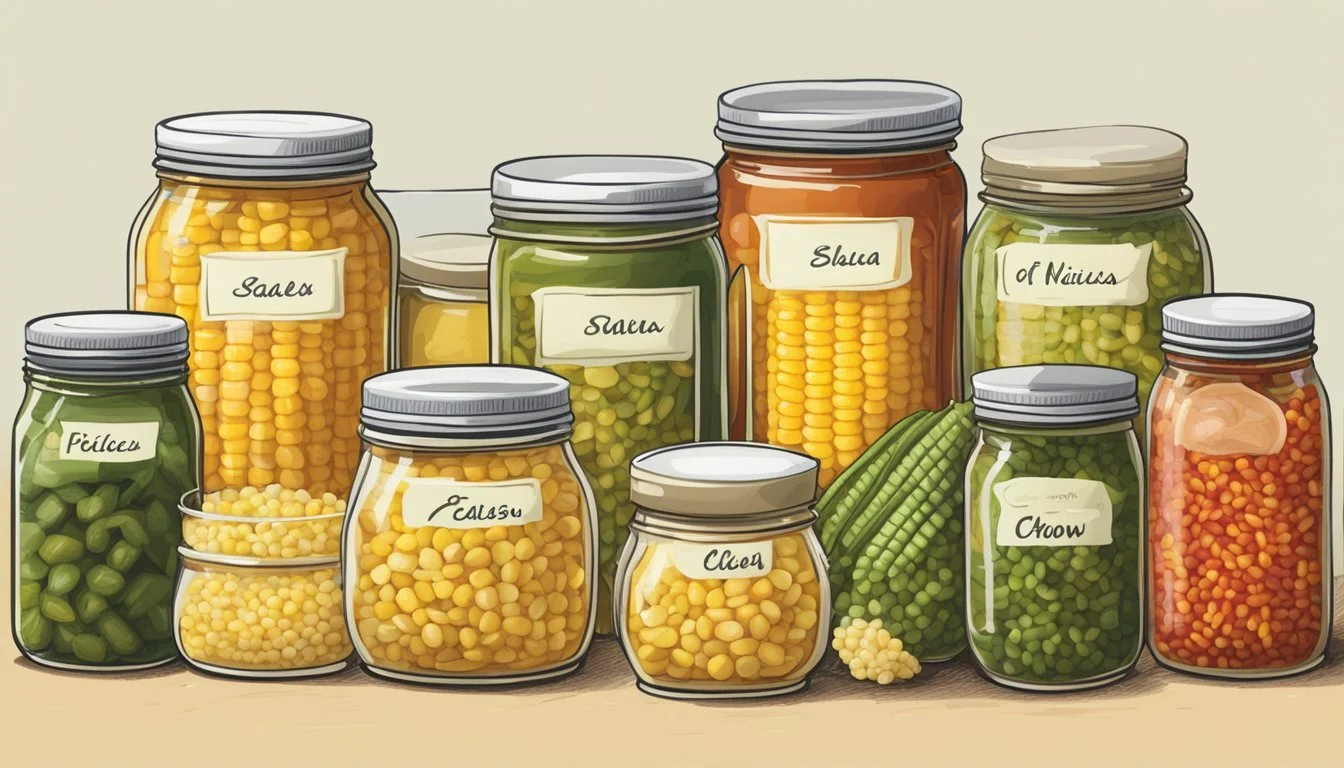Corn Relish Substitutes
Best Alternatives for Your Recipes
Corn relish, a delightful condiment, is known for its sweet and tangy flavor that enlivens a variety of dishes. When you find yourself missing this key ingredient in your cooking, there are several substitutes that can effectively replicate its taste and texture. Giardiniera, an Italian pickled vegetable mix, offers a blend of tangy and spicy flavors, making it an excellent alternative to corn relish in sandwiches and salads.
For those who prefer a homemade twist, marinated celery with wine vinegar and olive oil, mixed with minced garlic, onion, capers, and herbs, can serve as a great substitute. This combination mimics the sweet and sour profile of corn relish and can be easily adjusted to suit any recipe. Additionally, cucumbers marinated with similar ingredients can also stand in for corn relish, adding a refreshing crunch to your dishes.
With these substitutes, you can continue to create delicious recipes without compromising flavor. Whether you're enhancing a summer barbecue spread or simply adding zest to your meals, these alternatives ensure that your culinary creations remain vibrant and satisfying.
Understanding Corn Relish
Corn relish is a vibrant, tangy condiment that complements various dishes. This section explores its history, nutritional benefits, culinary uses, and distinctive flavor profile and texture.
History and Cultural Significance
Corn relish has roots in American cuisine, particularly in the South, where it has been a staple for centuries. Originating as a way to preserve summer's sweet corn, this relish became popular due to its balance of tangy and sweet flavors. Early settlers utilized vinegar and spices to extend the shelf life of vegetables, making corn relish a common sight at family gatherings and picnics. Its cultural significance endures today, with many families preserving their own versions, often passed down through generations.
Nutritional Composition
Corn relish combines sweet corn, vinegar, sugar, and spices, resulting in a flavorful yet nutritious addition to meals. Typically, 2 tablespoons of corn relish contain about 21 calories, making it a low-calorie condiment. Its sodium content, around 106 mg, provides a tangy taste while remaining relatively low. This relish offers a small amount of vitamins and minerals from the vegetables used. For those seeking a healthier version, sugar-free or salt-free alternatives can be made, reducing calories and sodium even further.
Common Uses in Cooking
Corn relish's versatility makes it a popular choice in various culinary applications. Frequently used as a topping for hot dogs, burgers, and sandwiches, it adds a tangy, sweet contrast to the savory elements. It's also a delightful addition to salads, providing a crunchy texture and burst of flavor. In Southwestern cuisine, it often accompanies grilled meats or is mixed into salsas. Its balance of acidity and sweetness enhances many dishes, making it a go-to condiment for grilling and summer barbecues.
Flavor Profile and Texture
The flavor profile of corn relish is characterized by a perfect blend of tangy vinegar and sweetness from sugar and sweet corn. The addition of spices like mustard seed and celery seed adds depth and complexity. Texture-wise, it's crunchy and crisp, thanks to the fresh vegetables used. This combination of tangy, sweet, and crunchy makes corn relish a refreshing contrast to rich, savory dishes. Whether homemade or store-bought, its zesty nature lifts the flavors of whatever it accompanies.
Ideal Substitutes for Corn Relish
For those seeking alternatives to corn relish, consider various options that maintain a relevant flavor and texture. Explore sweet and savory substitutes, as well as dips, spreads, and even homemade concoctions that can serve as excellent replacements.
Sweet Pickle Relish Alternatives
Sweet Pickle Relish: This is one of the closest substitutes in terms of sweetness and crunch. Use it in a 1:1 ratio to maintain the same balance in recipes.
Chopped Sweet Pickles: For a similar sweet flavor and crunchy texture, chopped sweet pickles work wonders. They bring a comparable blend without drastically altering the dish.
Green Tomato Relish: Its sweet and tangy profile makes it a versatile substitute, especially useful in salads and sandwiches.
Savory Options
Dill Pickle Relish: Offers a tangy flavor profile with a distinctly savory edge. It adds a different dimension while keeping the crunch alive.
Giardiniera: This Italian mix includes cauliflower, carrots, and peppers, adding a blend of tangy and spicy notes. It's ideal for sandwiches and salads.
Capers: Spicy, lemony, and vinegary in flavor, capers bring a savory punch, particularly effective in dressings and dips.
Dips and Spreads
Chutney: Variants like mango chutney or apple butter provide an interesting sweet-savory twist. They can be used in dishes that require a touch of sweetness with depth.
Pickled Onions: These offer a tangy sharpness that can enhance spreads and dips, contributing a unique flavor and texture.
Green Olives: With their pronounced briny notes, green olives can replace corn relish in spreads, giving a salty-savory flavor boost.
Homemade Variations
Homemade Sweet Pickle Relish: Making your own relish allows control over the sweetness and texture, ensuring it fits perfectly with your dish.
Quick Pickle Mix: Combine chopped cucumbers, a bit of sugar, vinegar, and a pinch of salt. This mix can serve as a fast homemade substitute for corn relish.
Water Bath Canning: Prepare and preserve your variations using canning jars and a water bath method. This technique helps maintain a fresh and crunchy flavor over time.
Each substitute has its unique flavor profile, balance, and crunch, providing versatile options depending on your culinary needs.
Choosing the Right Substitute
Selecting a suitable corn relish substitute involves balancing flavors, considering texture, calculating quantities, and addressing dietary needs.
Balancing Flavors and Ingredients
When choosing a substitute, it's essential to match the sweet and tangy profile of corn relish. Look at how ingredients like vinegar, sugar, and salt combine to create a balanced taste.
For instance, a mix of chopped cucumbers with vinegar and a touch of sugar can mimic the tanginess and sweetness. Adding minced garlic and onion enhances the depth of flavor.
Green bell peppers with a bit of vinegar and sugar can also work well. Always aim to adjust the seasoning to your taste preference, taking care to balance the sour, sweet, and salty elements.
Considering Texture and Crunch
Texture plays a vital role in the overall experience of corn relish. Substitutes should provide a satisfying crunch to match that of corn kernels.
Celery is a good candidate due to its natural crunch. Marinating chopped celery stalks in vinegar and olive oil, with added herbs, can achieve a similar crunch and flavor.
Capers could be considered for a different texture but they offer a unique, tangy burst that can complement various dishes.
Calculating Quantities and Ratios
Adjusting quantities is critical when substituting ingredients. The goal is to maintain the original recipe's balance and consistency.
For example, if replacing corn relish with chopped cucumbers, ensure you use a similar volume.
This helps retain the balance of the dish. Calculate the ratios of vinegar, sugar, and salt accordingly to avoid overpowering other flavors. A useful tip is to start with smaller amounts and gradually adjust until you reach the desired taste.
Allergy and Dietary Adjustments
Allergy and dietary needs must be considered to ensure everyone can enjoy the dish.
For allergies to common relish ingredients like bell peppers, consider alternatives such as diced zucchini or carrots after ensuring there are no cross-reactivities.
Dietary restrictions like sugar intake can be managed by using sugar substitutes like stevia or honey.
Additionally, for those avoiding vinegar, lemon juice can provide a similar tangy effect without compromising dietary guidelines. Always tailor the ingredients to fit specific dietary and allergy requirements.
Careful attention to these details ensures the substitute meets everyone's needs while still delivering on flavor and texture.
Creative Uses in Dishes
Corn relish is a versatile ingredient that can transform ordinary dishes into extraordinary culinary delights. It pairs well with meats, works perfectly in vegetarian or vegan meals, and adds a refreshing twist to salads.
Enhancing Classic Recipes
Corn relish can add a burst of flavor to classic recipes. Mixing it into potato salad or tuna salad provides a zesty tang that complements the creamy textures of these dishes. It's excellent in deviled eggs, adding both visual appeal and a hint of sweetness and acidity that balance the richness of the egg yolk mixture. Adding corn relish to burgers and hotdogs is a simple way to elevate basic grilled staples with minimal effort.
Innovative Pairings with Meats
When paired with grilled meats, corn relish shines by adding brightness and contrast. Try serving it atop grilled chicken or steak for a fresh accompaniment that counters the smokiness of the meat. It also works well in tacos, providing a crunchy texture and sweet-tart flavor that pairs well with spiced ground beef or shredded pork. For a thoughtful garnish, use corn relish on bratwurst or sausages, delivering an unexpected twist.
Vegetarian and Vegan Combinations
Corn relish is a fantastic addition to vegetarian and vegan dishes. It can be mixed into grain bowls or quinoa salads, providing a pop of color and flavor. It's also great as a topping for vegan tacos, combining well with black beans, avocado, and salsa. In stir-fries, corn relish can act as a flavorful component, adding both moisture and crunch to the mix of vegetables.
Refreshing Salad Mix-ins
Adding corn relish to salads adds a unique element. In a green salad, it can replace traditional dressings, offering a lower-calorie option packed with flavor. For a Southwestern-style salad, it pairs excellently with black beans, roasted peppers, and avocado. Tuna salad benefits from the inclusion of corn relish, yielding a more vibrant and textured dish. Even pasta salads can be enhanced, providing a contrasting flavor and texture to the creamy pasta.
Using corn relish creatively in these dishes can bring new and exciting flavors to your meals, making them more enjoyable and memorable.
Tips for Preservation and Storage
Proper preservation and storage techniques can help maintain the quality, texture, and flavor profile of corn relish for longer periods. Here, we explore optimal methods including canning basics, maintaining flavor and freshness, and freezing and refrigeration practices.
Canning Basics
To preserve corn relish through canning, it's essential to use sterilized canning jars and lids. Begin by preparing a water bath canner. Fill it with water enough to cover the jars by at least an inch and heat it to a simmer.
Fill the jars with hot corn relish, ensuring a headspace of about half an inch. Wipe the rims clean before sealing them tightly with lids. Place the jars in the canner and ensure they're submerged in boiling water for about 15 minutes to eliminate bacteria.
After processing, carefully remove the jars. Allow them to cool at room temperature before checking the seals. Any unsealed jars should be refrigerated and used promptly.
Maintaining Flavor and Freshness
Maintaining the flavor and freshness of corn relish involves monitoring the environment where jars are stored. Store them in a cool, dark place away from direct sunlight and fluctuating temperatures. To enhance the flavor profile, use fresh ingredients like sweet corn, and add spices such as freeze-dried dill sparingly.
Avoid excessive boiling during preparation, which can degrade the texture and reduce the relish's natural sour flavor. Once opened, corn relish can maintain its taste if refrigerated and consumed within a month. Always use clean utensils to avoid contamination.
Freezing and Refrigeration Practices
Another method for preserving corn relish is freezing, which can extend its shelf life without compromising much on quality. To freeze, let the relish cool completely before transferring it to airtight, freezer-safe containers. Leave enough headspace for expansion, then label and date each container for easy identification.
For refrigeration, ensure the relish is stored in an air-tight container to prevent moisture loss and contamination. It can stay fresh for several weeks this way. When thawing frozen relish, transfer it to the refrigerator and consume it within a week for the best flavor and texture.
Through properly executed preservation techniques, corn relish can be enjoyed well beyond its preparation time, providing a versatile and delicious addition to many meals.






